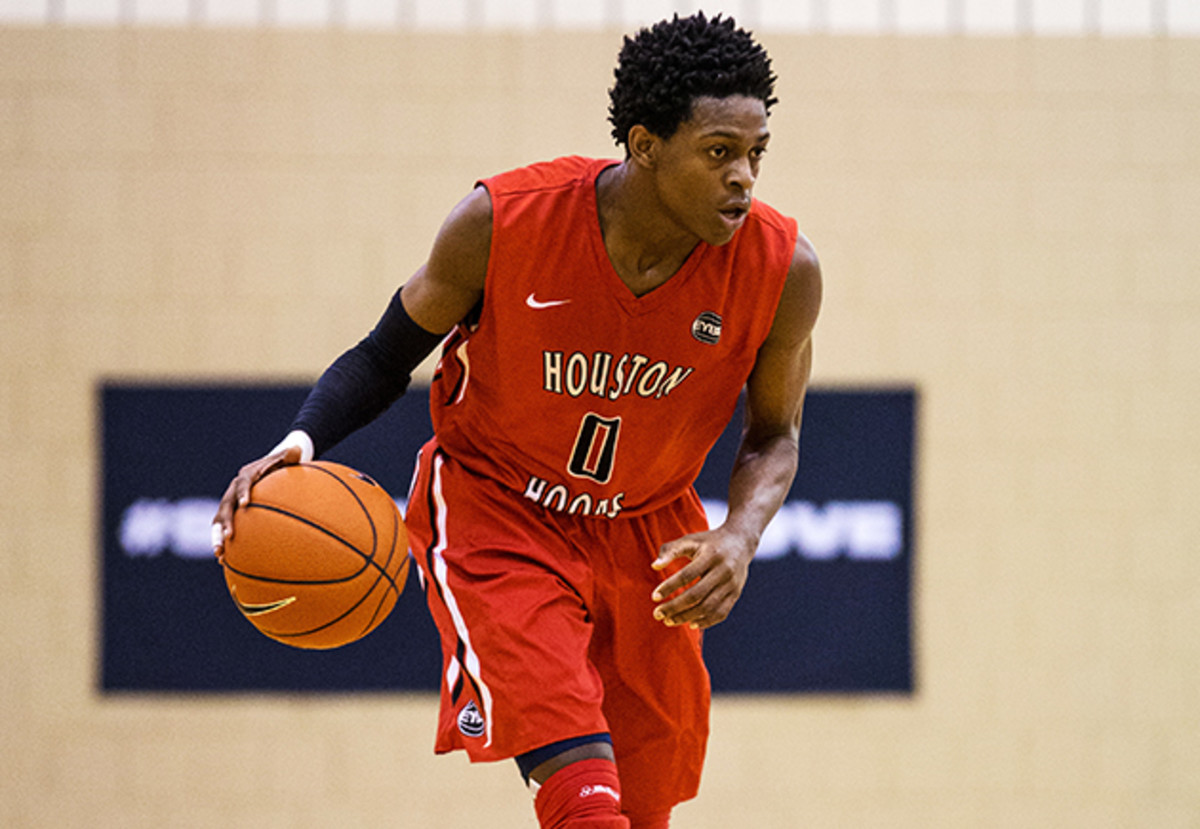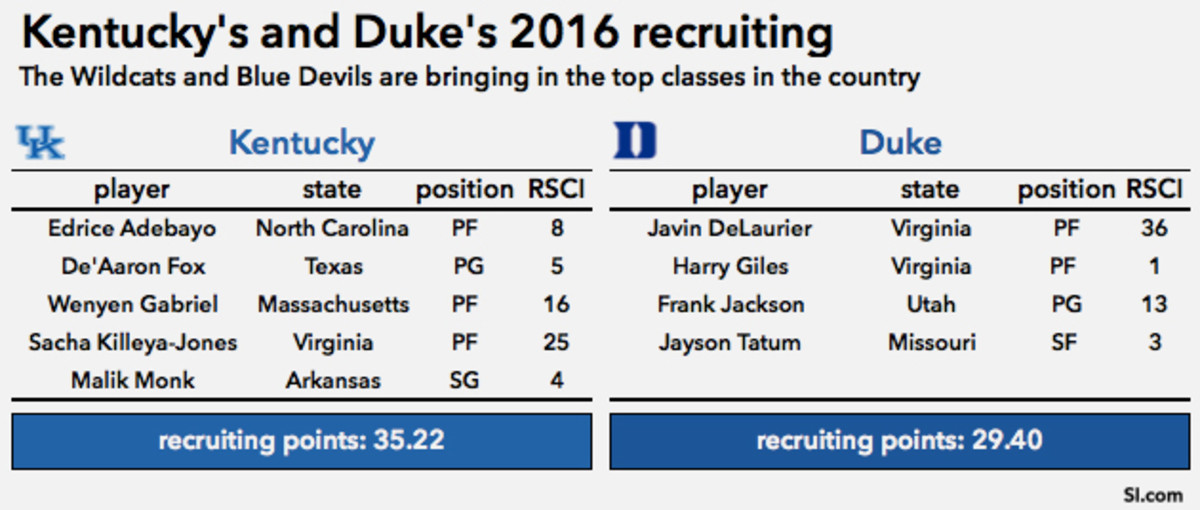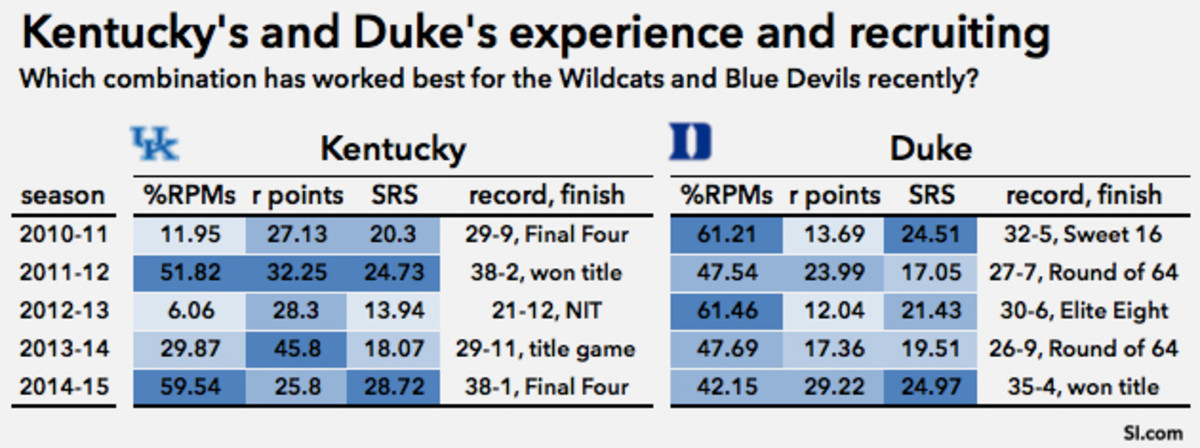With elite recruiting classes, Duke and UK already look like 2017’s top teams

For the last five years, the Champions Classic has served as a showcase for a group of the best teams and players in the country. The annual doubleheader featuring Duke, Kansas, Kentucky and Michigan State is a rare must-watch event for both college and NBA fans, as it provides an early look at All-America candidates and potential first-round draft picks. From the Spartans' Draymond Green to the Wildcats' Julius Randle to the Jayhawks' Andrew Wiggins to the Blue Devils' Jahlil Okafor, the Classic has shined a bright light on some of the sport’s biggest young stars.
This year’s version was, predictably, awesome. Duke, Kentucky and Michigan State are all coming off Final Four trips and the Wildcats (No. 2), Jayhawks (No. 4). Blue Devils (No. 5) and Spartans (No. 13) ranked in the top 15 of the AP's poll. In the opener, Kentucky’s trio of guards—Tyler Ulis, Jamal Murray and Isaiah Briscoe—dazzled with their offensive skills and defensive intensity to lead a comfortable win over defending national champion Duke, while in the second game, Michigan State senior Denzel Valentine delivered a triple-double to help the Spartans beat Kansas.
What we learned from Kentucky and Michigan State’s wins in Chicago
As entertaining as those contests were, it was hard to refrain from looking ahead to next year's Classic at Madison Square Garden. Five days before the Wildcats beat the Blue Devils, Duke announced that it had signed four recruits in the class of 2016: power forwards Harry Giles and Javin DeLaurier, small forward Jayson Tatum and point guard Frank Jackson. At the time, the group was hailed as the best in the country—a staggering collection of talent in the backcourt, frontcourt and on the wing—but that distinction was fleeting.
Only two days after the Classic, Kentucky officially announced its ‘16 recruiting class. The haul does not include anyone as heralded as Giles or Tatum, but it scored higher marks than Duke’s because of everything it does include: arguably the nation’s best point guard (De’Aaron Fox), an electric scorer who’s drawn comparisons to Russell Westbrook (Malik Monk), a physical big man who plays above the rim (Edrice “Bam” Adebayo) and two skilled power forwards with upside (Sacha Killeya-Jones and Wenyen Gabriel).
This method of roster upkeep—plucking from the upper crust of the prep ranks and plugging in really good players year after year—is nothing new for these two programs, which also occupied the No. 1 and No. 2 spots in the national recruiting rankings, according to Rivals.com, in 2014 and '15. But there is a sense from scouts that the class of 2016, top to bottom, is among the best in a long time.
Top 2016 recruit Harry Giles commits to Duke
In Giles, the top-ranked player according to the most recent edition of the Recruiting Services Consensus Index (RSCI), Duke is getting a skilled scorer and versatile defender who could be the first pick in the 2017 draft if he regains his form after suffering a second major knee injury this fall. If healthy, there’s little reason to think Giles won’t start in Durham right away. DeLaurier (No. 36) doesn’t project as a one-and-done, but his stock rose this year while he drew praise for his energetic play and could develop into a valuable multi-year contributor for the Blue Devils. Keep in mind that Duke loses two of its most important big men, seniors Amile Jefferson and Marshall Plumlee, after this season.
Then there’s Tatum (No. 3), a smooth wing who leaves the distinct impression that he can score when he wants, from wherever he wants. He’ll give the Blue Devils a perimeter threat in halfcourt sets that they’ve lacked so far this season. “I think, from all the kids I’ve seen in high school, he was the best scorer, because he can score in a variety of ways,” Duke coach Mike Krzyzewski said of Tatum, on the school's Web site. “He’s over 6'8", and he can shoot the ball extremely well, but he can also drive it, he can also post. He’s a good passer and defender. He can play multiple positions.”
Jackson (No. 13), meanwhile, is a capable scorer and facilitator who can play on or off the ball. His versatility will give Krzyzewski more flexibility with a backcourt rotation featuring several players who may be back next season, including Grayson Allen, Matt Jones, Luke Kennard and Derryck Thornton.

While Duke entered November's early signing period having already earned verbal pledges from its four signees, Kentucky had gotten commitments from only Gabriel and Killeya-Jones. (Power forward Tai Wynyard, a native of New Zealand, committed in January and also signed earlier this month but he’s expected to join the program in the second half of this season.) Over the next week, the Wildcats would add three five-star prospects (Adebayo, Fox and Monk), all of whom are ranked in the top 10 of the RSCI and are currently pegged as top-10 picks in the 2017 NBA draft by the scouting service DraftExpress.
It’s hard to say how Fox and Monk will fit into Kentucky’s backcourt. Briscoe, Murray and Ulis probably won’t all be back in 2016–17, though at least one of the three could return. Fox, the latest in a string of top-flight point guards to play for John Calipari, separates himself from a stacked group of players at that position in the 2016 class with his quickness, playmaking and defense. And Monk is an explosive scorer who can bury jumpers and finish with verve. He and Fox can function well in tandem, and their addition ensures the Wildcats will still have a potent backcourt regardless of who leaves for the NBA.
Kentucky's frontcourt should be in pretty good shape, too. Adebayo, Gabriel and Killeya-Jones could all get significant minutes in their first college seasons considering current Wildcats freshman Skal Labissiere may be selected in the top five of the 2016 draft if he declares and junior Marcus Lee is a projected second-rounder.
Elite 2016 big man Edrice “Bam” Adebayo commits to Kentucky
Adebayo, in particular, is already a force on the blocks who can run the floor, convert from close range and contest shots in the paint. “Of all the players I saw in the summer, no one had a combination of a dominating spirit and a physical presence like Bam,” Calipari said of Adebayo on UK's Web site. “He has a skill level of a player that is normally four inches smaller than him. Aside from his rebounding ability, he plays positionless basketball, just like our other kids. Bam is going to be a big-time player for us.”
Which program has the "better" class right now completely misses the point. The title carries little import, even at a time in which Duke and Kentucky have separated themselves from the rest of the sport when it comes to securing the nation’s top players. The value of most recruiting classes is not rendered for years down the line and are based on a number of factors, including NBA draft decisions, prospects’ fits and their physical readiness for the rigors of the college game.
That said, one way to get an idea of how these two groups stack up against each other involves a curve popularized by Boston Celtics staffer Drew Cannon in which the No. 1 player in the country is assessed 10 points, the No. 10 player gets seven points, the No. 25 player gets five points, the No. 50 player gets three points and the No. 100 player gets one point. Using the RSCI for rankings, Kentucky currently leads Duke by nearly six points.

The influx of talent is astounding; five of the 10 best players in the country will be sporting Pantone 286 or Pantone 287 uniforms in a year’s time. It also aroused my curiosity about the composition of Duke’s and Kentucky’s rosters in recent years. More specifically, have both programs won more games after bringing in higher-rated recruiting classes? Or have they been more successful with more experienced players? More young talent is never a bad thing, and anecdotally, freshmen have been instrumental in each school's most recent national championship.
In 2011–12, Calipari rode Anthony Davis, Michael Kidd-Gilchrist and Marquis Teague to a top-eight standing in offensive and defensive efficiency, a 38–2 record, a perfect mark against SEC competition and a remarkably smooth run through the NCAA tournament, where the Wildcats won each of their six games by at least eight points. And one need look no further than the Blue Devils’ win over Wisconsin in the title game last April—in which freshmen accounted for 88% of their scoring—to see how Krzyzewski can leverage highly touted prospects to build great teams.
That victory invited comparisons between Duke and Kentucky. The Blue Devils, it seemed, had taken a page from the Wildcats’ one-and-done playbook. But Duke also got important contributions from upperclassmen like Jefferson, Jones and the since-graduated Quinn Cook. Kentucky, too, leaned on a senior (Darius Miller) and a pair of sophomores (Terrence Jones, Doron Lamb) to cut down the nets in New Orleans in 2012. Though it’s obvious neither program can be completely dependent on freshmen, less clear is the blend of youth and experience that has worked best for the Blue Devils and Wildcats.

A review of the past five seasons shows that Kentucky, the poster child for NBA-departure-induced roster churn, has excelled when it experiences less turnover. The Wildcats posted their highest marks in Simple Rating System—a metric incorporating point differential and schedule strength—when they returned a substantial number of minutes and possessions. To gauge this, I used John Gasaway’s possession-minutes, which takes into account the percentage of possessions players use and the time they spend on the court. I applied Cannon’s curve to measure recruiting success.
Last season was peak Kentucky, if you will.
Though the Wildcats’ didn’t feature one of the most highly touted freshmen classes of Calipari’s tenure, they brought back Willie Cauley-Stein, the Harrison twins, Alex Poythress and Dakari Johnson. The least successful Kentucky season reviewed was 2012–13, in which it returned only 6.06% of possession-minutes, lost center Nerlens Noel to an ACL injury in February and was upset in the first round of the NIT. In 2013–14, Kentucky had a prodigious freshmen class but was just 24-10 entering the NCAAs before marching to the national championship game despite a comparatively low level of experience.
After Kentucky humbling, Duke’s Grayson Allen dazzles at 2K Classic
By contrast, not once over the previous five years did Duke return less than 40% of its possession-minutes. That's not to say the Blue Devils’ formula hasn’t changed. When Duke won it all in 2010, it had brought back 63.7% of its possession-minutes and reeled in a freshmen class with slightly more than half as many recruiting points as its 2016 class. Last season made plain that Duke has since beefed up its recruiting; the downside is that a heaping chunk of possessions and minutes vanished when Okafor, Jones and Justise Winslow declared for the draft.
These figures can be a bit deceiving. For example, neither the Blue Devils' Allen nor the Wildcats' Lee had previously logged major minutes, but both players are former McDonald’s All-Americans with NBA potential who could shine in bigger roles this season. It’s also important to keep in mind that rankings are relative. The No. 1 prospect in one class could be better or worse than the No. 1 prospect in another class. Less than a month into 2015–16, the 2015 class is already being labeled “bad,” while for months the 2016 class has been described in hyperbolic terms.
*****
What should we expect from Duke and Kentucky in 2016–17? Both programs could add to their already stellar recruiting classes in the coming months. Yet recent history shows that success for the Blue Devils and the Wildcats will also depend on who returns after this season. For Duke, Plumlee and Jefferson will be gone, and Allen, Thornton and 6'9" freshman forward Brandon Ingram could potentially turn pro. Kentucky may lose Briscoe, Labissiere, Lee, Murray and Ulis to the draft, and Poythress is a senior.
Tempting though it was, in the aftermath of their recruiting victories, to declare the Blue Devils and Wildcats 2017 Final Four locks, it’d be foolish to ignore another Champions Classic participant, Michigan State. The Spartans signed four top-50 prospects, including No. 9, small forward and one-time Kentucky target Miles Bridges, and are considered a prime contender for the No. 2 prospect, shooting guard Josh Jackson. Get him on board and, making due allowance for The Izzo Factor, Michigan State could give the Wildcats and Blue Devils a tough battle in November—and March.
But right now, Duke and Kentucky reside at the top of everyone’s future college basketball power rankings. By virtue of their incoming talent, the Blue Devils and the Wildcats will enter 2016–17 in position to compete for national championships no matter which players return. For most programs, it’s way too early to suggest as much. For Duke and Kentucky, it’s not.
